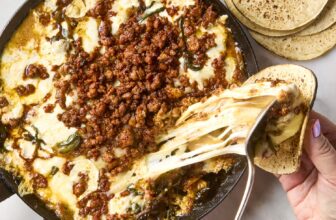
Kimbap is a classic Korean seaweed rice roll filled with seasoned beef, colorful vegetables, omelette strips, and pickled daikon. It‘s so popular in Japan to pack for lunch, picnics, and a meal on the go! Learn to make gorgeous seaweed rolls with my step-by-step guide.
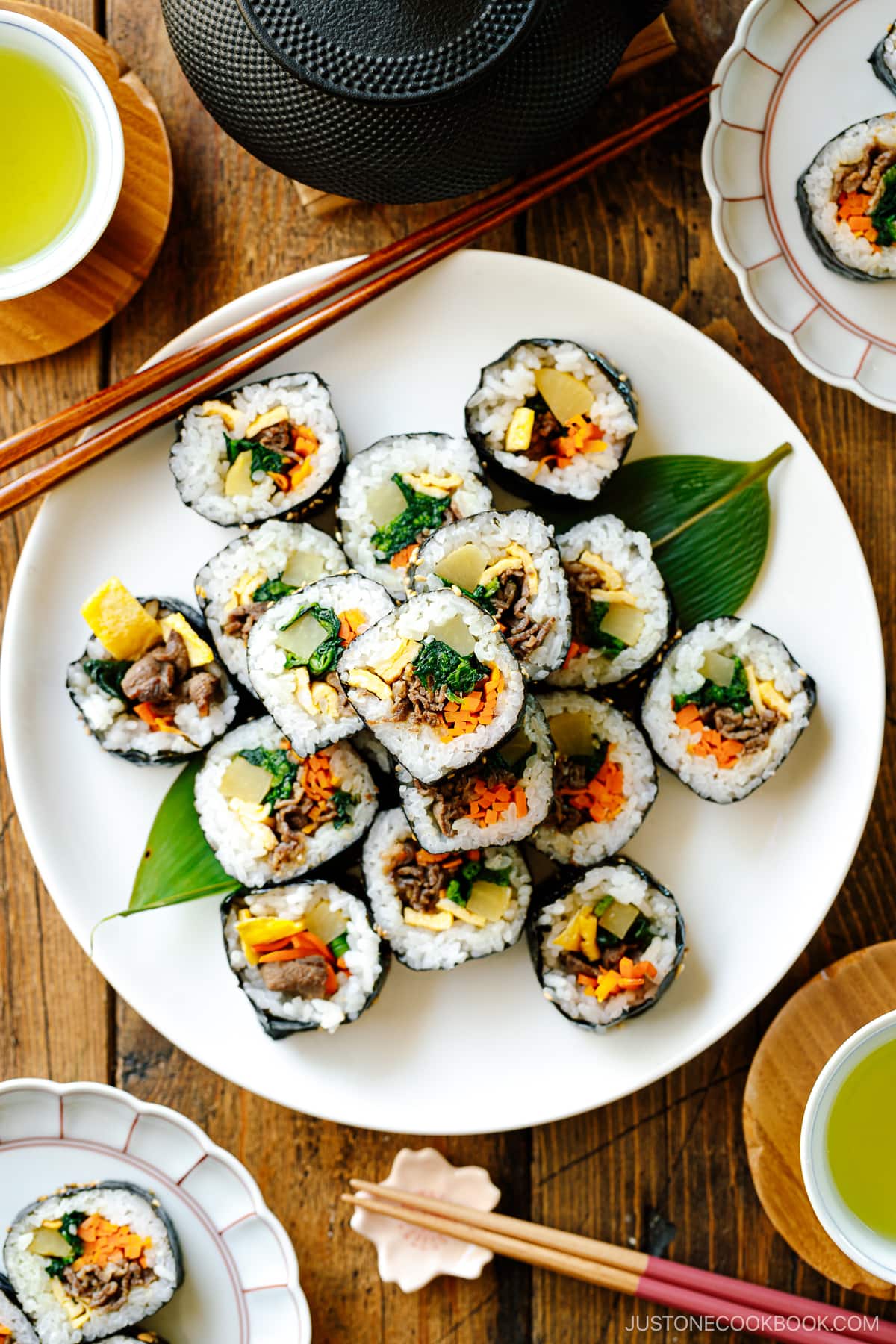
Today, I’m sharing my personal recipe for Kimbap, the delicious Korean seaweed rice roll. My kids love it and I make it at home often! It’s a casual and satisfying handheld food that I feed my busy teens as they’re coming and going from one activity to the next.
You might wonder, “Why is a Korean recipe on a Japanese food blog?” Actually, Korean cuisine is very popular in Japan these days, where you can easily find kimbap at supermarkets and convenience stores. Japanese also enjoy making these rolls at home and packing them for lunch or a picnic. It’s become so mainstream that uncut kimbap has become a popular choice for the Setsubun festival on February 3rd, when Japanese traditionally eat Ehōmaki, an uncut sushi roll, like a burrito.
Much like Japanese onigiri (rice balls), kimbap is the ultimate convenience food! If you haven’t tried these Korean seaweed rolls yet, I know you’ll love them. Read on, and I’ll teach you how I make beautiful kimbap rolls with my step-by-step instructions and techniques.
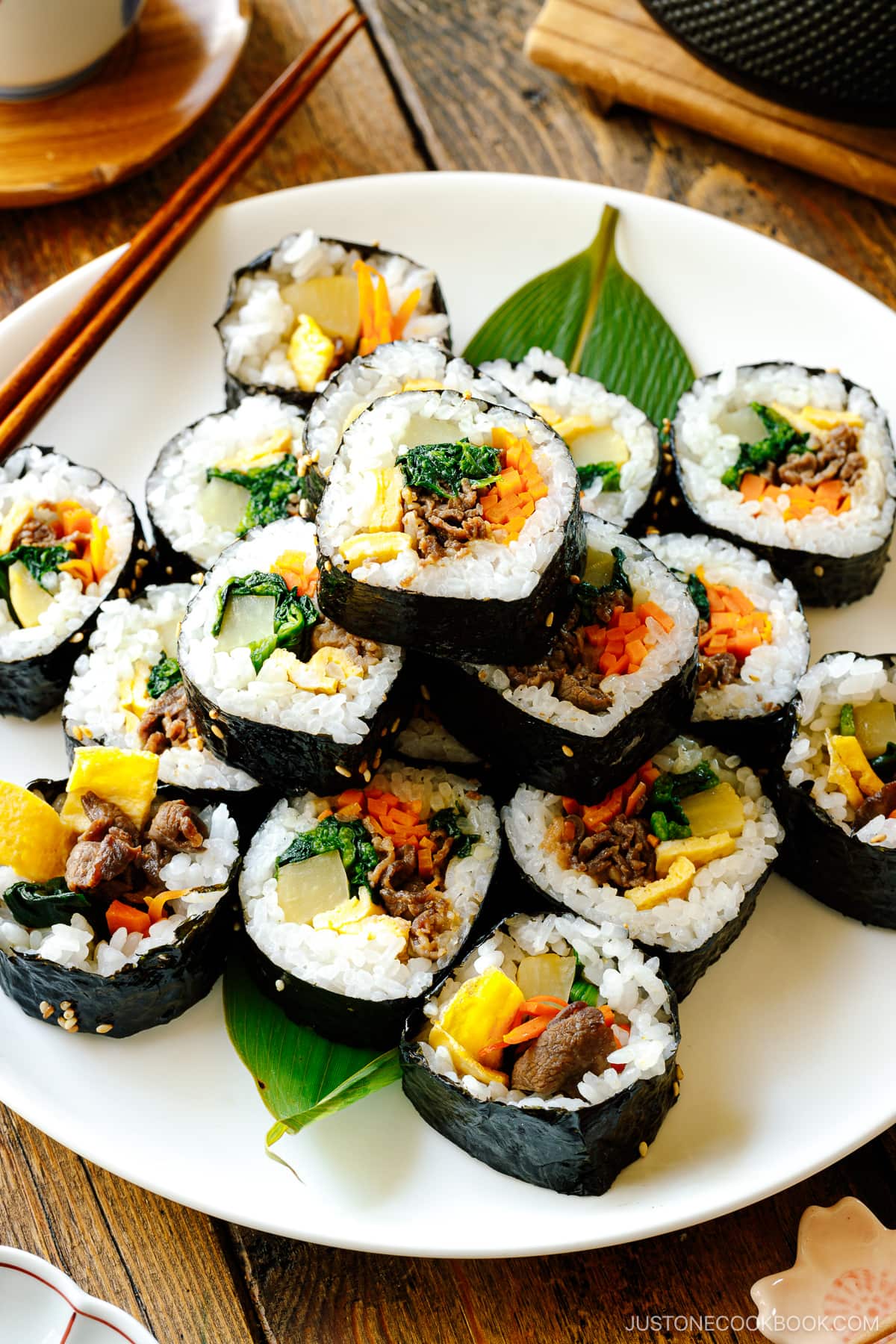
What is Kimbap?
Kimbap (김밥), also known as gimbap, is a traditional Korean seaweed (kim) and rice (bap) roll. It looks very similar to sushi, but there are slightly different.
Kimbap vs. Sushi Roll
For kimbap, the rice is either plain or seasoned with sesame oil and salt, while the seaweed is brushed with sesame oil and sprinkled with sesame seeds. The fillings are usually cooked or pickled ingredients.
For a sushi roll, the rice is seasoned with vinegar, sugar, and salt. The fillings are generally raw fish or some cooked ingredients.
Authentic Kimbap Recipes
I’ve seen how kimbap is made countless times and know how to make sushi rolls, so the kimbap recipe I’m sharing here is how I’d usually make it. For an authentic kimbap recipe, I encourage you to visit the websites of my dear Korean friends and learn more about this dish and other delicious recipes. I’ve known them for a long time, and their recipes never disappoint me! I’ve linked to their kimbap recipes below:
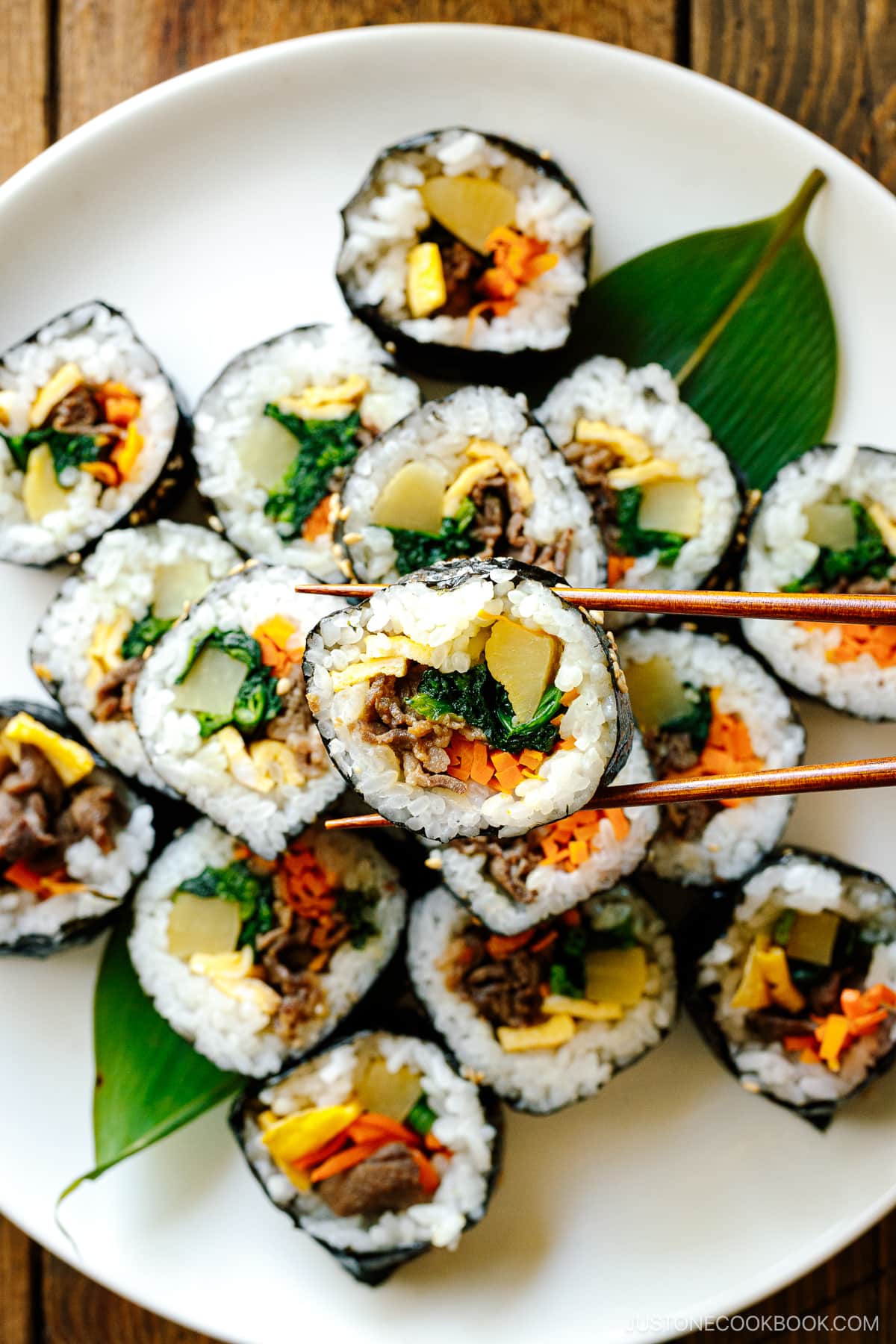
Ingredients for Kimbap
You’ll need seaweed, short-grain rice, protein, and vegetables for a basic kimbap roll:
- Nori (dried laver seaweed) sheets: Aim for good-quality nori sheets; Otherwise, the nori may become too chewy and gummy.
- Cooked short-grain white rice: You’ll need about 1 cup of cooked rice per roll.
- Protein: I used bulgogi-style seasoned beef and egg omelette strips.
- Colorful vegetables: Cooked and seasoned carrot and spinach add vibrant color, texture, and nutrients. Pickled daikon (takuan) adds a tangy crunch!
- Toasted sesame oil: Brush it on top of the rolled Kimbap for a lovely aroma and taste.
How to Make the Best Kimbap
Follow my cooking steps and rolling techniques for perfect Korean seaweed rice rolls every time!
- Soak and cook the rice. After you wash the rice, soak it for 20–30 minutes to help absorb water into the core of the kernel.
- Marinate the beef. Toss the meat in the marinade and allow it to sit while you prepare the other fillings.
- Prepare the fillings. Fry the omelette, pan-fry the carrot and spinach, pan-fry the beef, cut the pickled daikon radish.
- Roll the Kimbap. Spread a thin layer of cooked rice on the nori sheet, neatly add the fillings, and roll with a bamboo mat.
- Brush with sesame oil on top and sprinkle with sesame seeds.
- Cut and serve at room temperature.
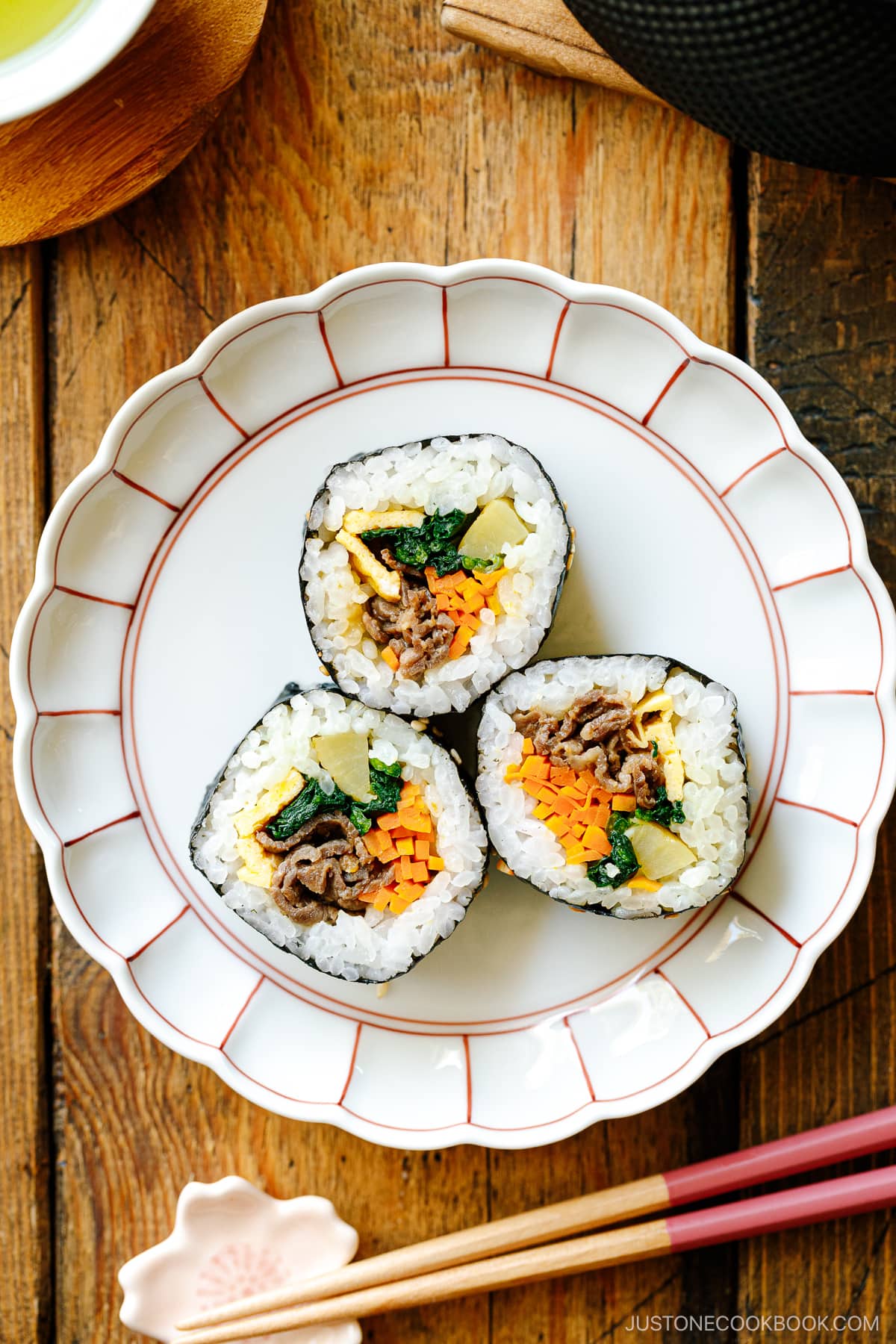
Substitution Tips and Variations
You can certainly use and experiment with other ingredients as well.
- Change up the protein with fish cake strips, imitation crab sticks (kanikama), chicken, pork belly, spicy pork, or even ham. You can skip the meat or fish to make it vegetarian, or omit the egg to make it vegan.
- Try adding other vegetables like simmered burdock root, cucumber strips, lettuce, and perilla leaves (shiso). Bean sprout namul and napa cabbage kimchi are other delicious filling options.
- Add gochujang (Korean chili paste) to your beef marinade or cooked vegetables for a spicy-sweet umami kick.
Recipe Tips and Techniques
- Prepare the filling ingredients while the rice is soaking and cooking. It takes about an hour to soak and cook the rice. During this time, you can marinate the beef, fry the omelette, and cut and cook the vegetables.
- Use thinly sliced beef that‘s easy to marinate, cook, and slice. You can find it at a Korean or Japanese market. You can also slice meat thinly at home.
- Pan-fry the fillings in the order shown in the recipe card. If you cook the lightly-seasoned ingredients first and end with the heavily-seasoned ingredients, then you only have to wash the frying pan once after you finish cooking everything.
- Use water to moisten your fingers and measuring cup to keep the cooked rice from sticking.
- Spread the rice evenly on the nori sheet to create an even shape and uniform thickness across your roll.
- Add the fillings in the right order, starting with the smaller ingredients and ending with the easy-to-hold ingredients. This is the key to holding the stacked filling in place as you roll the kimbap. You’ll be rewarded with a beautiful cross section when you slice the rolls!
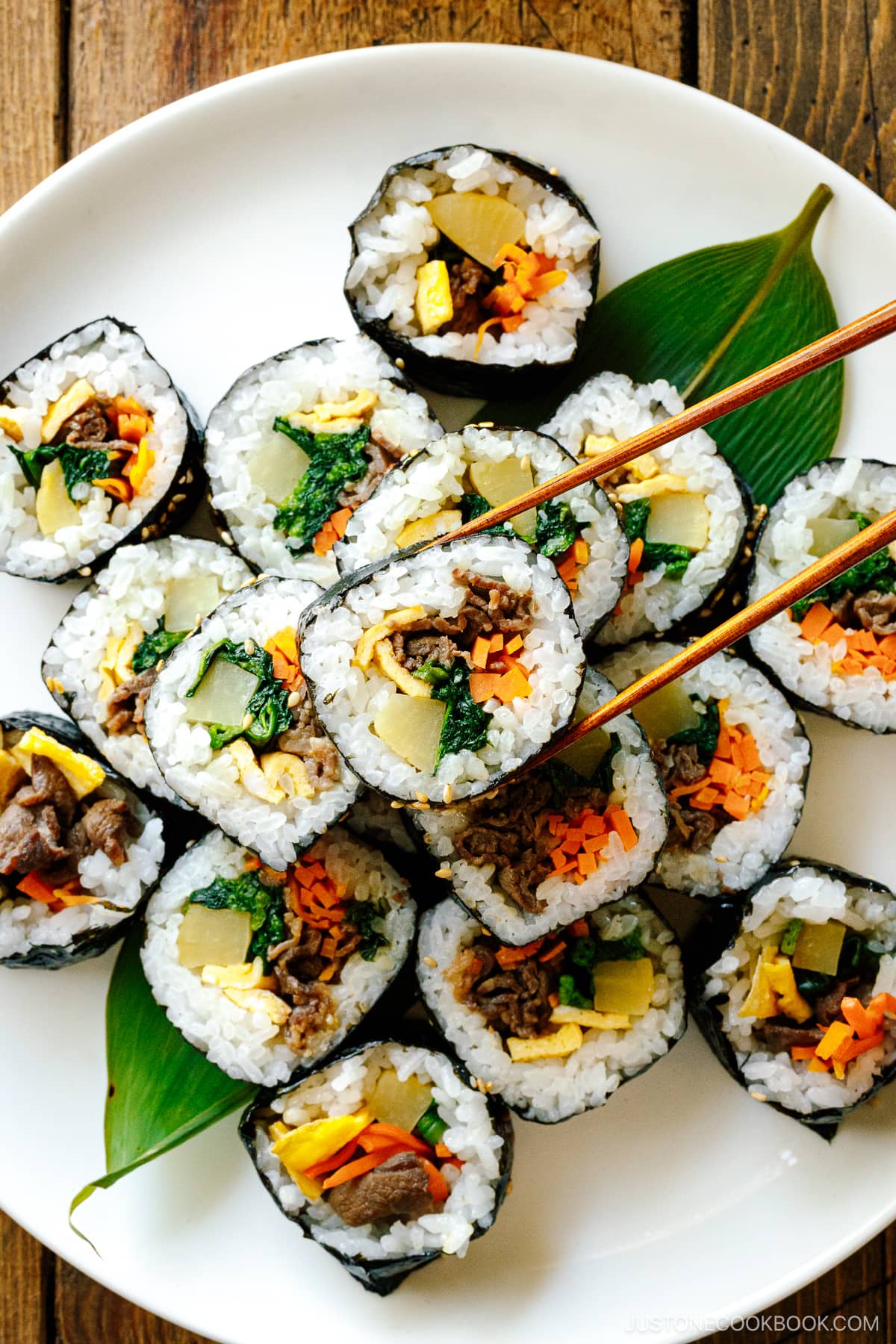
How to Store
It‘s best to enjoy kimbap the same day you make them, like sushi. Try not to refrigerate kimbap unless you need to keep it for the next day, as the rice can become hard and dry. If you need to refrigerate them, wrap the rolls in plastic and a thick kitchen towel to keep the rice cool and safe without getting cold.
What to Serve with Kimbap
Kimbap is wonderful served as a complete meal on the go in your lunchbox. It’s a fun family meal or party food to serve cut and stacked in a tower on a large platter. You can also serve it as an appetizer or a side dish (banchan) alongside other dishes. Try some of our favorite Korean recipes to serve with Kimbap:
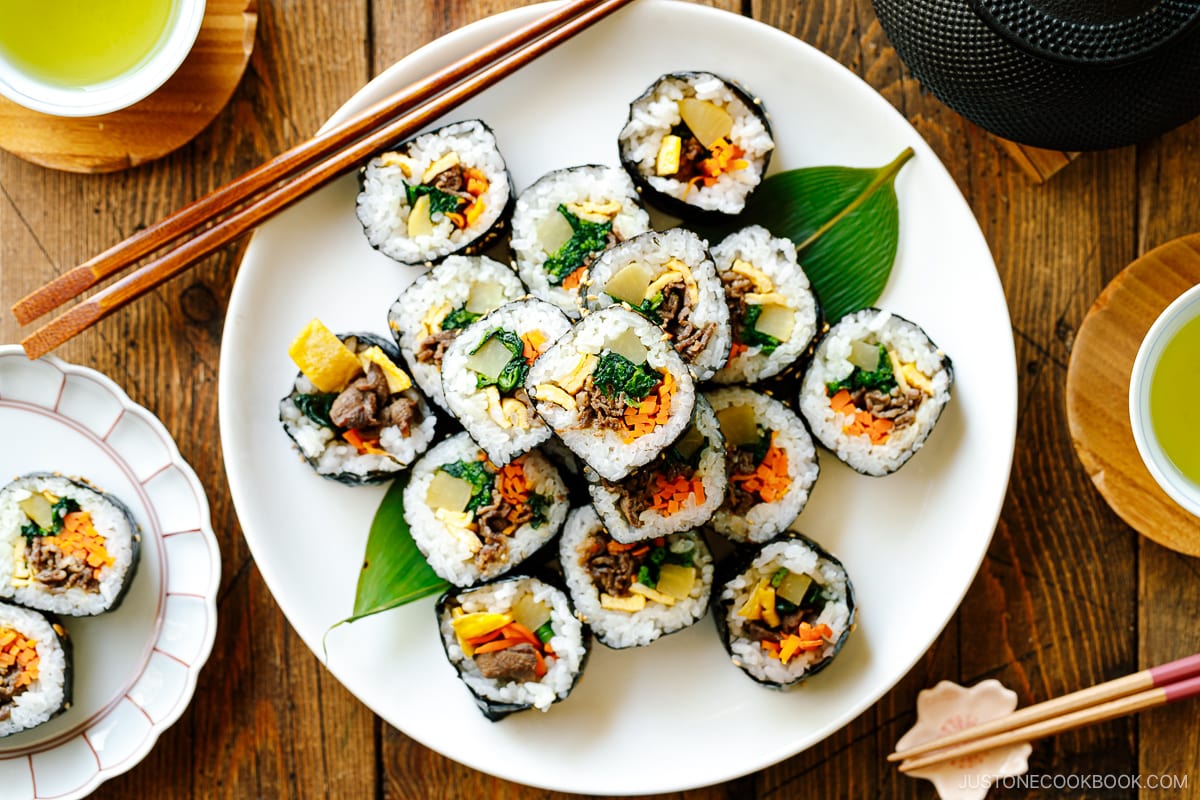
Wish to learn more about Japanese cooking? Sign up for our free newsletter to receive cooking tips & recipe updates! And stay in touch with me on Facebook, Pinterest, YouTube, and Instagram.
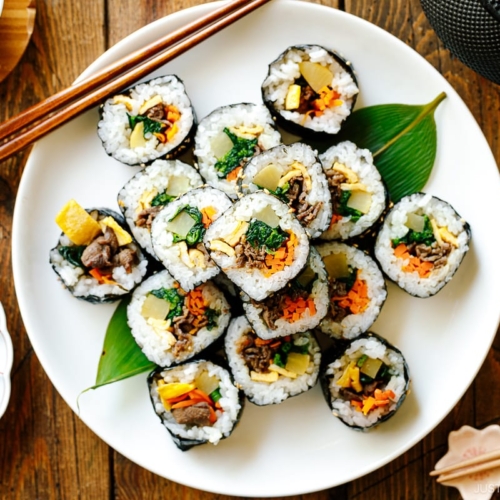
Kimbap
Kimbap is a classic Korean seaweed rice roll filled with seasoned beef, colorful vegetables, omelette strips, and pickled daikon. It‘s so popular in Japan to pack for lunch, picnics, and a meal on the go! Learn to make gorgeous seaweed rolls with my step-by-step guide.
Servings: 6 rolls (8 cut pieces per roll)
Ingredients
Prevent your screen from going dark
Instructions
-
Gather all the ingredients. I recommend following the order of my preparation steps. If you start with the lightly-seasoned ingredients and end with the heavily-seasoned ingredients, then you don‘t have to wash the frying pan until you finish cooking everything.
To Cook the Rice
-
Wash and Rinse: Add 2¼ cups uncooked Japanese short-grain white rice to a large bowl. Add enough cold tap water to wet the rice, then drain. Use your fingers to gently agitate and “wash“ the wet rice grains in a circular motion for 10–15 seconds. Add water to the bowl to rinse, then immediately pour off the cloudy water. Repeat this wash and rinse step two more times or until the water is almost clear. Then, drain the rice well in a fine-mesh sieve and shake off any excess water.
-
Soak and Cook: Transfer the well-drained rice to the inner pot of a rice cooker. Add 2½ cups water to the pot and level the rice. Let the rice soak in the water for 20–30 minutes. Then, start cooking. If you don‘t have a rice cooker, you can cook the rice in a pot on the stove, Instant Pot, or donabe. While the rice is soaking and cooking, prepare the filling ingredients.
To Prepare the Filling
-
Beef: In a medium bowl, combine the marinade ingredients: 2 Tbsp soy sauce, 2 tsp sugar, and 2 cloves garlic, crushed or minced (I use a garlic press). Mix it all together to dissolve the sugar.
-
Slice ½–¾ lb thinly sliced beef (chuck or ribeye) crosswise into pieces 3 inches (7.6 cm) wide. Add the beef to the marinade. Mix gently to separate the slices and thoroughly coat them with the seasonings. Set aside to marinate until you‘re ready to cook. Meanwhile, prepare the other ingredients.
-
Omelette: Crack 2 large eggs (50 g each w/o shell) into a bowl. Add 1 pinch Diamond Crystal kosher salt, then gently whisk. Do not overmix.
-
Heat a frying pan (I use an 11″ carbon steel pan) over medium heat. Then, add 1 Tbsp neutral oil to the pan. To check if the pan is hot enough, put a drop of the egg mixture in the pan. When you hear a sizzling sound, it‘s ready.
-
Pour the egg mixture into the pan. (If you‘re doubling the recipe, cook one omelette at a time.) Quickly tilt the pan to coat the entire cooking surface with the egg. As the egg cooks, poke any air bubbles to release the air.
-
Cook until the bottom of the egg is just set but not browned, about 2 minutes. Then, flip over the egg with a spatula and cook for another 2 minutes.
-
Transfer the omelette to a plate and let cool. Cut it into strips ½ inch (1.3 cm) wide. I folded the omelette in half before slicing to help cut the strips a uniform width. Place on a tray or plate.
-
Carrot: Peel 1 carrot, then shred into fine strips about 3–4 inches (7.5–10 cm) long using a julienne peeler.
-
Alternatively, you can use your knife to make julienned strips. Cut the carrot into sections about 3–4 inches (7.5–10 cm). Next, cut them lengthwise into ⅛–inch slabs. Stack these slabs and cut lengthwise into ⅛-inch strips.
-
Heat the same pan that you just used (without washing) over medium heat and add 1–3 tsp toasted sesame oil. When the oil is hot, add the carrot and 1 pinch Diamond Crystal kosher salt. Sauté until tender. Transfer to the plate or tray and let cool.
-
Spinach: Trim off a bit of the stem end of 1 bunch spinach. Cut the spinach in half crosswise to separate the leafy and stem parts.
-
Heat the same pan over medium heat and add 1–3 tsp toasted sesame oil. Add the bottom stem half of the spinach and 2 cloves garlic, minced or crushed (I use a garlic press).
-
Sauté until wilted. Then, add the top leafy half of the spinach and 1 pinch Diamond Crystal kosher salt. Sauté again until wilted, then transfer to the plate or tray and let cool.
-
Beef: Heat the same pan over medium heat and add 1–3 tsp toasted sesame oil. When it‘s hot, add the marinated beef and marinade.
-
Sauté until the beef is cooked through and all the moisture has evaporated. Transfer to the plate or tray with the vegetables to let cool.
-
Pickled daikon: Cut 1 takuan (pickled daikon radish) into long slabs ⅓ inch (8 mm) thick and the same length as the nori sheets. Then, cut the slabs into long sticks. Add it to the plate or tray with the other ingredients.
To Fill and Roll the Kimbap
-
Now, add one portion of each filling to the center/middle of the rice, lining up the ingredients in strips across the width of the nori. Start with the smaller ingredients like the carrots and beef.
-
Add the spinach. End with the easy-to-hold ingredients like the omelette strips and pickled daikon. Tip: Do your best to stack the ingredients onto each other neatly and evenly across the width of the nori. This helps to create an even thickness and uniform shape for your rolls.
-
Grab the bottom edge of the mat with your index fingers and thumbs while using your other fingers to hold the filling in place. Start rolling the bottom end of the nori sheet over the filling. Use the bamboo mat to roll tightly and firmly until the bottom edge of the rice meets the rice on the other side of the ingredients.
-
Here‘s a side view of the edge being rolled up.
-
With one hand, firmly hold the roll and mat down. With your other hand, grab the top end of the mat. Then, pull the two against and away from each other to tighten the roll. Start in the center, then repeat on the left and right sides.
-
Lift up the end of the mat off of the roll, then finish rolling the rest of the way.
-
Once you finish rolling, press firmly on top with your fingers to shape the roll evenly. Transfer the roll, seam side down, to the tray or baking sheet lined with parchment paper. Cover with plastic wrap to keep it from drying out as you continue to make the rest of the rolls.
-
Remove the plastic from the Kimbap. Brush the tops lightly with the remaining toasted sesame oil and sprinkle with 2 Tbsp toasted white sesame seeds on top.
To Store
-
It‘s best to enjoy the Kimbap the same day you make them. Like sushi, don‘t refrigerate kimbap unless you need to keep it for the next day, as rice gets hard and dry when cold. If you need to refrigerate them, I recommend that you wrap the Kimbap in plastic and then a thick kitchen towel, so the rice will stay cool and safe, but not get cold.





